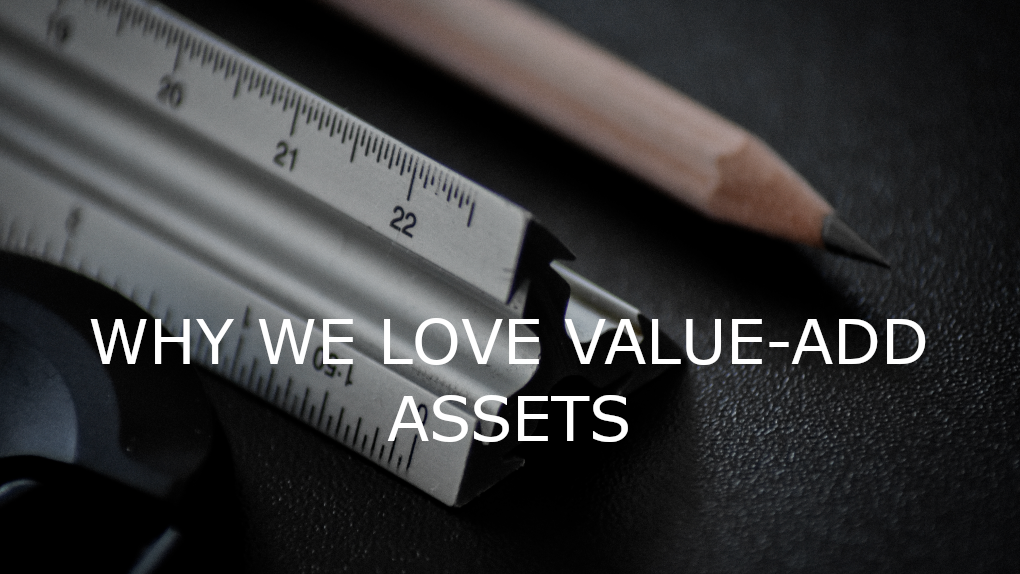The Allure of Value-Add Commercial Properties
Topic: BASIC KNOWLEDGE • By: Michael Lewis • 02-16-2019
It’s no secret that we love value-add commercial properties.
Value-add means different things to different investors. We consider value-add properties to be modest performers with a straightforward approach to increase revenue, reduce expenses, or both. They “work” as-is, but there’s a big, relatively safe, upside.
Think of an apartment complex in a hot market with 12-year-old kitchens in the units. We might buy this property at a low price, renovate it, and raise the rents. Maybe we decide we can raise the rents by $100/month if we spend $5,000 per unit on kitchen renovations. But does that expense warrant the potential profit? Is the investment worthwhile?
In this way, a value-add project can be similar to flipping a house. We spend some money on renovations, then make more money then we spent when we sell the asset. The scale is much bigger, obviously. Another major difference is how apartment buildings and other commercial assets are valued.
The Income Generated Determines the Value of a Commercial Property
If I list my house for sale, my real estate agent will likely “run comps” to determine its value. Running comps simply means using a simple version of the sales comparison approach to appraise real property. If the house across the street is exactly like mine and sold recently for $700,000, my house is worth about $700,000. That’s the idea.
It is important to know about recent sales of commercial properties too, but not for the same reasons.
First, we need to understand the relative liquidity of a market and asset class to forecast eventual sale. If it takes two years to sell an apartment complex like the one we will be selling in the future, we need to know that.
Second, we need to understand general market trends. If the market will be awash with apartment complexes like ours in five years, we need to know that too.
Third, we need to know the “cap rate” of a market and asset class. We need to have some idea whether the cap rate is changing too. We’ll get to that a bit later.
For now, the point is that commercial properties are not generally valued based on the sale price of properties with similar physical characteristics. We don’t “run comps” to decide how much to pay for an apartment complex.
Business Basics
Before I dive into cap rates, it’s important to make sure that everybody understands some basic business terms. This is a very brief overview. I’ll use a multifamily property as the example, but the concepts are the same across all businesses.
Gross revenue is the total amount of sales or receipts for a particular period. An apartment complex with 10 units renting for $1,000 per month has $10,000 in monthly gross revenue (and $120,000 in annual gross revenue). This is overly simplistic because of fees and other sources of revenue, but that’s the idea.
Next we have Net Operating Income (NOI). This is the Gross Revenue minus all reasonably necessary operating expenses. Items like insurance, property management, utilities, repairs, and maintenance are all subtracted from the gross revenue to yield NOI. Notice that I did not deduct anything for payment of any loan encumbering the asset (e.g., mortgage payments). Those aren’t “expenses” for purposes of calculating NOI. NOI is just the gross revenue minus the expenses of operating the asset. For our purposes here, just assume that it’s a cash purchase.
The Income Capitalization Approach
Now that we understand how NOI is calculated, I can explain how valuation of multifamily and commercial assets differs from valuation of my residence. To value multifamily properties, we don’t use the sales comparison approach. We use the Income Capitalization Approach. The basic premise is: the higher the earnings, the higher the value, provided the amount of risk remains constant.
Commercial Property Valuation: higher earnings = higher value
This is how we determine whether to spend $5,000/unit in renovation costs to increase rent by $100/month.
Step one is determining the income. $100/month equals $1,200/year.
Step two is capitalizing the income; and we need to know the capitalization rate (“cap rate”) to do this.
Capitalization Rates
The calculation of a cap rate is simple.
Capitalization Rate = NOI ÷ Current Market Value of Asset
If a property has a stabilized NOI of $100,000, and sales for $2,000,000, the cap rate is 5%.
$100,000[NOI] / $2,000,000 [Value] = 5% [Cap Rate]
But what’s the cap rate actually telling us?
Another way to think about a cap rate is: the cap rate represents the annual return an investor should expect to earn with an all-cash purchase. If the same building is purchased for $2,000,000 cash, the investor earns $100,000 after he deducts his operating expenses from gross revenue. His NOI is $100,000. That’s a 5% annual return on his purchase price of $2,000,000. Because of fundamentals inherent in the market, cap rates for more risky assets are higher. This means they cost less in proportion to the percentage return generated. Risky assets are cheaper. Cap rates for ultra-safe assets are lower. This means ultra-safe assets are expensive and, therefore, provide lower returns.
Cap rates in a particular market are generally known based on prior sales of similar assets. Commercial brokers, for example, circulate information regarding gross revenue and NOI when offering an asset for sale. They also compute the sales price based on their opinion regarding the appropriate cap rate for the asset. By thoroughly understanding a market, we know the cap rates in a particular area and asset class.
Why is this important?
Let’s return to the original question. Does a monthly rent increase of $100/unit justify $5,000/unit in renovation costs? Is the investment worthwhile?
Let’s say that this is a garden apartment complex with 100 units and the capitalization rate is exactly 5% for the neighborhood and asset class.
First, we look at the increased income. $100 per unit multiplied by 100 units equals $10,000 per month. That’s a potential increase of $120,000 to annual gross revenue. Let’s say the operational expenses will largely remain the same. Therefore, NOI is increased by $120,000.
With a 5% cap rate, our $120,000 boost to NOI is worth $2.4 million. [$120,000/5% = $2.4 million]
Remember: NOI / Value = Cap Rate. To refresh your algebra, that means: NOI / Cap Rate = Value. In this case $120,000/5% = $2.4 million.
The cost of the renovation is $5,000/unit multiplied by 100 units. That’s only $500,000.
For $500,000 in renovations, we increase the property value by $2.4 million.
This is too simplistic for our real world analysis, but it’s a perfect example to explain this concept.
In reality, we perform a discounted cash flow analysis (among others) and thoroughly underwrite the investment through our anticipated term of ownership before inviting investors to join us in any value-add project. That’s how we can project a very specific target IRR, AAR, and Equity Multiple for investors.
As a passive investor, however, you should understand that the cap rate acts like a value multiplier–which creates fantastic upside opportunities.
The magic of earnings multiples
That’s the magic of the income capitalization approach and one of the many things that make investing in commercial properties lucrative.
The cap rate acts as a multiplier for value.
| Cap Rate | 10% | 9% | 8% | 7% | 6% | 5% | 4% |
| Multiplier | 10.00 | 11.11 | 12.50 | 14.29 | 16.67 | 20.00 | 25.00 |
Remember that NOI is Gross Revenue minus expenses.
For every $100 we increase gross revenue or decrease expenses, the property value increases by $2,000 (if we sell at a 5% cap rate).
We love value-add properties.
This is the primary reason we love investing in value-add properties. Many properties are under-performing for a variety of reasons. The marketplace is full of inefficiencies. By adding a bit of revenue or cutting expenses modestly, we can dramatically increase value because of the way commercial and multifamily properties are valued.
We want you to be able to grow your wealth investing with Real Growth Capital.
Learn why compounding is the key to wealth creation.
That’s the goal. Growing your wealth. Money sitting in a CD or money market account isn’t growing. It’s just chasing inflation.
One final real world example of creating wealth
Finally, I want to tie the discussion of value-add properties back to wealth creation. The difference between a 10% return and a 15% return is massive because of compounding. $100,000 invested today with a compounded 10% return is worth $611,590 in 20 years. With a 15% annual return, the total payout more than doubles to $1.42 million. I know which return I would prefer.
Getting the highest possible return has major long-term consequences to wealth growth. Value-add properties are one way that Real Growth Capital helps investors achieve their wealth growth goals.

W. Michael Lewis
Michael Lewis is a licensed attorney with more than a decade of experience advising clients before founding Real Growth Capital. His expertise includes real estate investing, financial analysis, asset management, business strategy, and negotiation.






